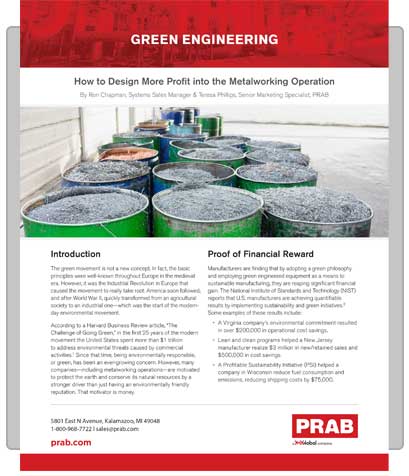
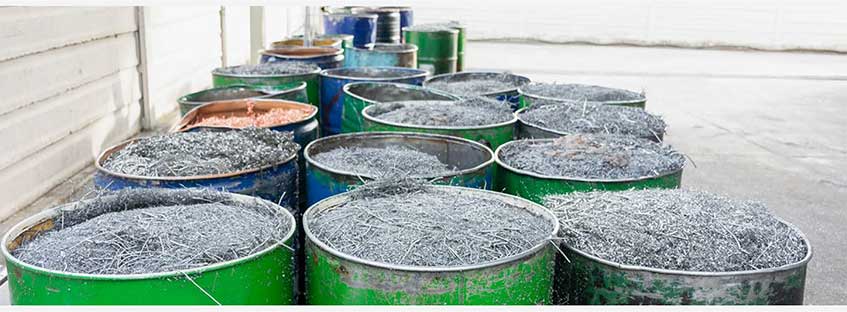
The green movement is not a new concept. In fact, the basic principles were well-known throughout Europe in the medieval era. However, it was the Industrial Revolution in Europe that caused the movement to really take root. America soon followed, and after World War II, quickly transformed from an agricultural society to an industrial one—which was the start of the modernday environmental movement.
According to a Harvard Business Review article, “The Challenge of Going Green,” in the first 25 years of the modern movement the United States spent more than $1 trillion to address environmental threats caused by commercial activities.1 Since that time, being environmentally responsible, or green, has been an ever-growing concern. However, many companies—including metalworking operations-are motivated to protect the earth and conserve its natural resources by a stronger driver than just having an environmentally friendly reputation. That motivator is money.
Manufacturers are finding that by adopting a green philosophy and employing green engineered equipment as a means to sustainable manufacturing, they are reaping significant financial gain. The National Institute of Standards and Technology (NIST) reports that U.S. manufacturers are achieving quantifiable results by implementing sustainability and green initiatives.2 Some examples of these results include:
Like these companies, metalworking operations that consciously take steps to be good to the environment by using less energy, producing less scrap, or eliminating hazardous waste disposal also see financial rewards for being green by shifting to green engineered equipment and processes centered on sustainable manufacturing.
While green manufacturing and sustainable manufacturing are not defined the same, they are closely related and often used interchangeably. According to Quality Digest’s article “Five Benefits of Sustainability and Green Manufacturing,” green manufacturing refers more to a single product or production process, while sustainable manufacturing is typically associated with an organization’s holistic approach-taking the entire production process and logistics into consideration.3
An article published by the Environmental Protection Agency (EPA) about sustainable manufacturing states that there are several reasons why companies are pursuing a green approach to sustainability:4
An April 2017 study published by the International Journal of Business and Social Science on green manufacturing and operational performance concludes that adopting green manufacturing practices has been proven to enhance operational performance.5
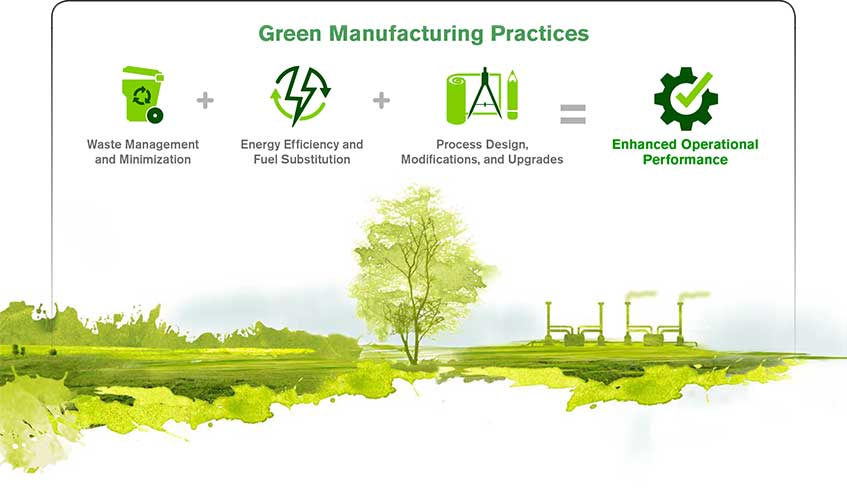
As defined by the EPA, green engineering is the design, commercialization, and use of processes and products that minimize pollution, promote sustainability, and protect human health without sacrificing economic viability and efficiency.6 Because of the many benefits, several international suppliers, including U.S.-based equipment manufacturer PRAB Inc., engineer and build all their systems with this green engineering philosophy. PRAB’s entire product line of metal scrap processing, fluid recycling, and wastewater treatment equipment are built to help manufacturers achieve their sustainability goals. They work with a wide range of industries within the metalworking sector to optimize their operational performance by improving the management of their metal scrap and fluid waste streams, extending tool life, reducing new coolant purchases, and helping them to meet or exceed compliance to strict environmental rules and regulations.
The American Foundry Society (AFS) states that, “From implementing management systems and metrics, to waste management and beneficial reuse, metal casters can play a key societal role in the sustainability of our natural resources.”7 One example of this is described in a case study8 published by the AFS about a project completed for a company’s tool room scrap metal recycling, where they realized several environmental and other benefits including:
Here are four very important ways that metalworking operations can use “green engineering” to improve their environmental footprint and bottom lines.
Before equipment suppliers specializing in green engineering can help metalworking operations save money, individual shops need to identify their profit drains. One of the first areas to analyze—regardless of facility size—is the waste stream. With green engineered equipment, this should be looked at as a revenue stream. An article published by The Fabricator magazine titled, “Do you manage scrap properly?,”9 states that scrap metal—in most instances—represents the second largest source of revenue for a metalworking operation. With that said, shops should find how much it costs to haul-away polluted metal scrap and used lubricants each month. Then, a monthly report with housekeeping numbers should be run to determine how much time and labor is being spent on removing this metal waste, along with other maintenance and cleaning required in their current scrap and fluid management process. Next, they should quantify their monthly expenditures on new lubricants, cutting fluids, and metals.
When the metalworking operation knows its waste stream spending, it can solicit green engineering equipment suppliers—like PRAB—to provide them with an efficient and reliable profit-building solution.

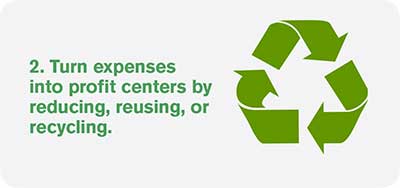
Around 10 years ago, most suppliers could only offer centralized metal chip processing, fluid recycling, and underground conveyor systems for waste stream management. But that has changed in these past years with the development of modular metal chip processing equipment and other turnkey systems, engineered for at-the-source (CNC or machining equipment) waste handling. With green engineered solutions, metalworking operations can:
Metalworking operations can also improve their profitability and conserve resources by prolonging the life of their tooling. Filtering fluid with the right recycling system has been proven to extend tool life by up to 25%.
A green approach not only saves money with improved waste stream management, it can also prevent hefty regulatory charges.
In the United States, the EPA governs the generation and disposal of hazardous waste under Title 40 CFR, part 261 (Identification and Listing of Hazardous Waste) and 279 (Used Oil Regulations).10 Metal scrap containing free flowing liquids is classified as hazardous wastes. Other countries also have environmental agencies and regulations that oversee and control hazardous or toxic substances.
Operators, maintenance, and other employees who handle these hazardous wastes are not always familiar with the monetary penalties for regulatory non-compliance. Nor are they aware that those penalties are often greater at the state and local levels. So, when employees take shortcuts or don’t follow hazardous waste handling procedures, they may not understand the financial repercussions.
That is why it’s advisable to inform employees during orientation and training of the financial impact EPA and environmental fines can have on the company and their jobs. Point out that non-compliance fines often increase with the amount of waste generated and repeat offenders are fined even higher. Managers and supervisors also need to know the costs associated with tracking and doing paperwork related to hazardous waste stream management.
If there are pollution issues with the drainage of water coming from the business or leakage from containers filled with wet chips, there is another cost threat—the saleability of the property. Business owners and stakeholders need to remember that proactive protection of their land and water can pay dividends in stable, or increase property values. It can also help to avoid large clean-up and property rehabilitation costs, and help maintain a good community reputation.
Incorporating green engineered equipment into the metalworking operation can alleviate these threats. Conveyors, carts, and dumpers, for example, can help shops safely contain hazardous materials and prevent spillage and fluid leaks that can contaminate the ground and water. Horizontal screw presses can dewater hazardous grinding swarf or filter cake by up to 85% and the extracted fluids can be disposed of safely.
As metalworking operations look at ways to increase their green profitability, ISO 14000 certification may provide a global foundation for improvements. These internationally recognized environmental management standards and guidelines help companies comply with regulations as well as reduce waste, improve process inefficiencies, and cut operational costs. Companies with ISO 14000 certification say that the guidelines keep them ready for regulatory inspections. But the certification can also improve the ability to get capital, lower insurance rates, simplify labeling, get permits, defend themselves in environmental litigation, and expand into global markets where the certification is requested or required.

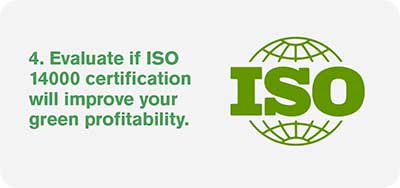
Whether a manufacturer chooses to apply for ISO 14000 certification, use green engineered equipment in its process, or both, the decision requires an investment. But, that investment can often be recouped in just months from the reduction in waste handling costs and the prudent selling or reuse of what was once hazardous scrap metal and cutting fluid. Being able to add that return to the bottom line makes being green definitely worth it.

Ron Chapman is Systems Sales Manager for PRAB and has more than 45 years of sales and engineering experience with a focus on industrial automation design.

Teresa Phillips is the Senior Marketing Specialist for PRAB and has over 18 years of marketing experience within the manufacturing sector.
1 Richard A. Clarke, Robert N. Stavins, J. Ladd Greeno, Joan L. Bavaria, Frances Cairncross, Daniel C. Esty, Bruce Smart, Johan Piet, Richard P. Wells, Rob Gray, Kurt Fischer, Johan Schot. “The Challenge of Going Green.” Harvard Business Review, 1 Aug. 2014 – https://hbr.org/1994/07/the-challenge-of-going-green
2 Brian Lagas. “Five Benefits of Embracing Sustainability and Green Manufacturing.” National Institute of Standards and Technology, U.S. Department of Commerce, 10 Sept. 2015 – https://www.nist.gov/blogs/manufacturing-innovation-blog/five-benefits-embracing-sustainability-and-green-manufacturing
3 Brian Lagas. “Five Benefits of Sustainability and Green Manufacturing.” Quality Digest, 11 Oct. 2016 – https://www.qualitydigest.com/inside/customer-care-column/five-benefits-sustainability-and-green-manufacturing-101816.html
4 “Sustainable Manufacturing.” EPA, Environmental Protection Agency, 21 June 2017 – https://www.epa.gov/sustainability/sustainable-manufacturing
5Selina M. Eshikumo, and Stephen O. Odock. “Green Manufacturing and Operational Performance of a Firm: Case of Cement Manufacturing in Kenya.” International Journal of Business and Social Science, vol. 8, no. 4, Apr. 2017, pp. 1–15., doi:10.33642/ijbass.
6 “Green Engineering.” EPA, Environmental Protection Agency, 14 Feb. 2017 – https://www.epa.gov/green-engineering
7 “Sustainability in Metalcasting.” AFS, American Foundry Society – https://www.afsinc.org/sustainability-metalcasting Accessed 18 July 2019.
8 American Foundry Society, Waste Management & Beneficial Reuse: Tool Room Scrap Metal Recycling – https://afsinc.s3.amazonaws.com/Documents/EHS/006%20Tool%20Room%20Scrap%20Metal%20Recycling.pdf Accessed 18 July 2019.
9 Thom Romer. “Do You Manage Scrap Properly?” The Fabricator, FMA Communications, Inc., 2 May 2016 – https://www.thefabricator.com/article/shopmanagement/do-you-manage-scrap-properly-
10 Resource Conservation and Recovery Act (RCRA) Regulations.” EPA, United States Environmental Protection Agency, 25 Feb. 2019 – https://www.epa.gov/rcra/resource-conservation-and-recovery-act-rcra-regulations